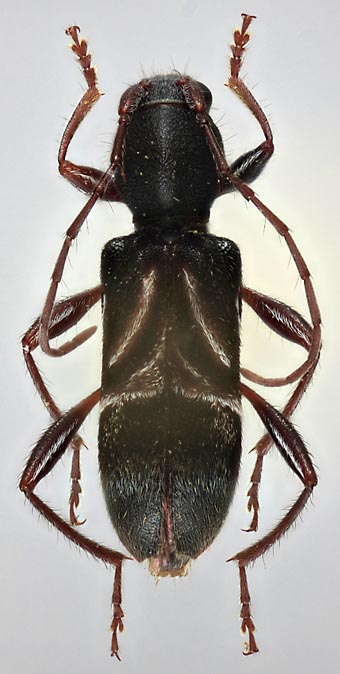 |
Anaglyptini
Classification
Introduction
- The tribe Anaglyptini Lacordaire, 1868 currently contains 106 species in 12 genera. Photographs of 1 exemplar specimen are currently available for this tribe.
Diagnostic Features of Adults
- Body small-sized, less than 10 mm; generally elongate. Eyes generally reniform, complete (not completely divided into upper and lower lobes). Antennae variable, generally filiform, rarely serrate, flabellate, or expanded laterally; with or without spines; antennal length variable, from short (not extending beyond tip of abdomen) to long (extending beyond tip of abdomen); antennae 11-segmented; antennomere III rarely distinctly swollen compared to segments V-XI. Pronotum generally elongate (distinctly longer than wide); lateral margins of pronotum unarmed, without distinct spines or tubercles; pronotum shape variable, distinctly narrower basally or not. Mesocoxal cavities closed to mesepimeron. Elytral apices variable, with or without distinct spices. Metafemoral length variable, from about as long to distinctly longer than profemora.
Diagnostic Features of Larvae
- These larvae are more slender in form than those of the Clytini and the ampullae are small, oval, with a deep median furrow. Head rather broad in front, produced by distinctly shouldered gena enclosing a large ocellus (larger than spiracles); last joint of maxillary palpi much longer than second; process of palpifer relatively large. Pronotum posteriorly striate, not projecting forward along median line, no median suture; no trace of ventro-lateral suture; sternellar fold distinct at extremities; legs two to four jointed, shorter than maxillary palpi. The characters suggest certain species of Callidiini. Adapted from Craighead (1923).
Geographic Distribution of Tribe
Biology and Economic Importance
- Biology unknown for most members of this tribe. Species of this tribe are potentially invasive outside their native range.
Selected References to Adult Specimens
Selected References to Larvae Specimens
|  |

Cyrtophorus verrucosus
(Olivier, 1795); dorsal
Cerambycidae:Cerambycinae:Anaglyptini
Photograph © E.H. Nearns
|




